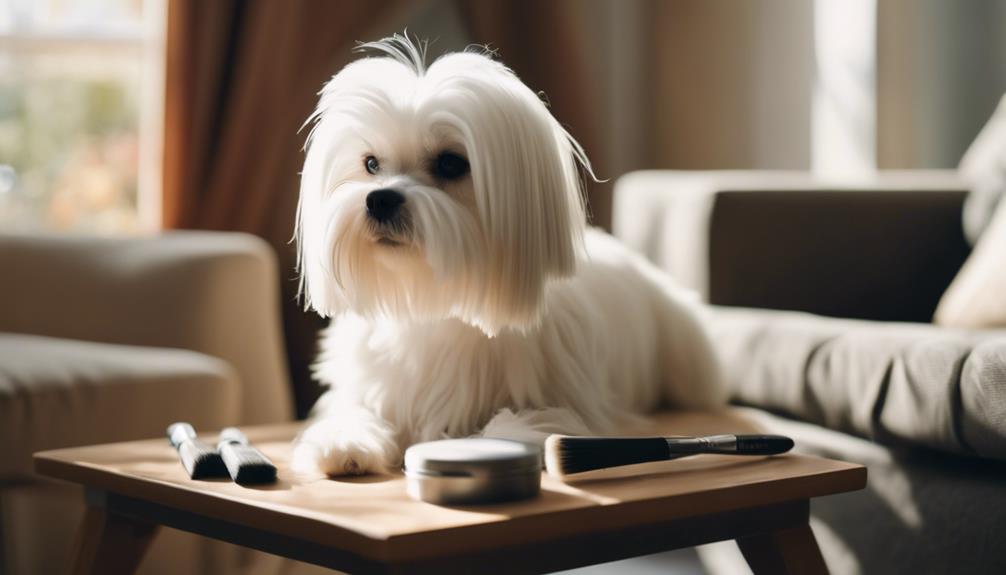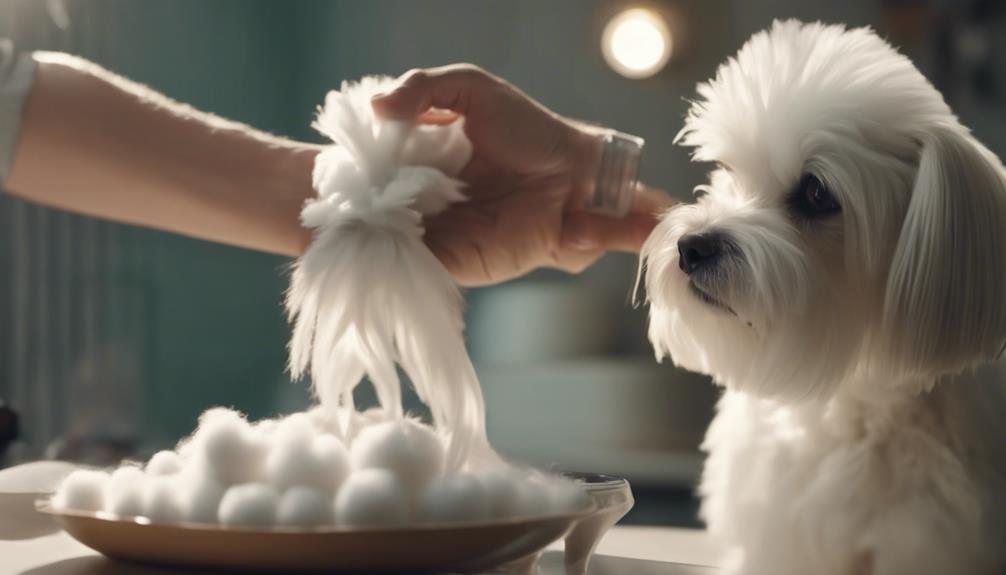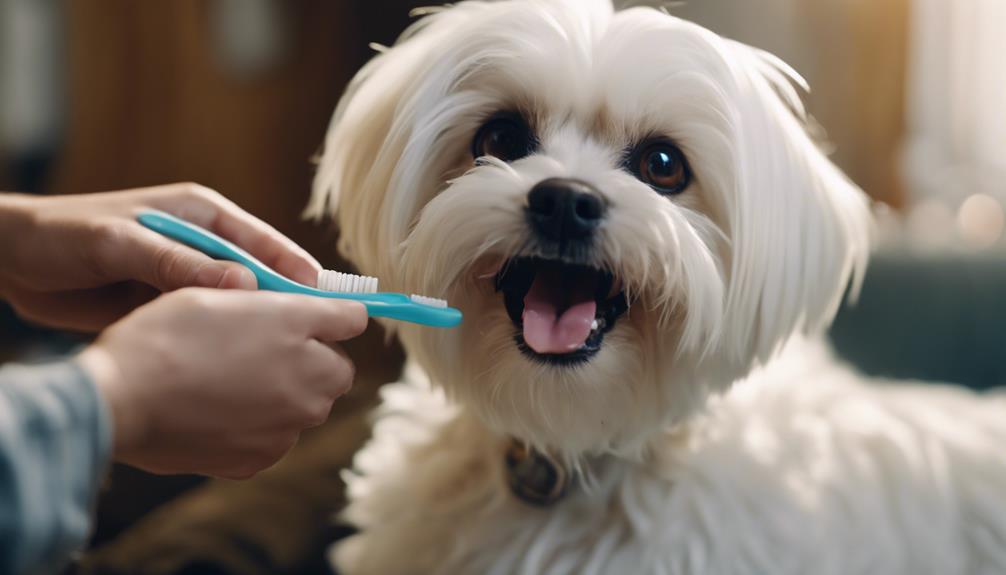As a Maltese owner, you're probably aware of the special grooming needs of your furry companion. With their luxurious, long coats, maintaining a regular and thorough grooming routine is vital. Let's start with brushing—you'll need to do it several times a week to prevent mats and tangles that can quickly become uncomfortable for your pet. But there's more to explore beyond just brushing. From managing tear stains to ensuring proper ear and dental care, each step is essential for your Maltese's health and appearance. Let's look at why these steps are important and how they contribute to the overall well-being of your dog.
Regular Brushing Techniques

To maintain your Maltese's coat smooth and tangle-free, start by gently brushing through it daily with a soft-bristled brush. This regular brushing not only helps guarantee mats but also distributes natural skin oils throughout their fur, maintaining its healthy sheen. Pay special attention to the areas behind the ears, under the armpits, and around the tail base, as these are common spots for knots to form.
You'll also need a slicker brush and a metal comb. Use the slicker brush to gently remove any loose hair and detangle. Work in sections, lifting the hair upwards and brushing from the skin outward to make sure you're thoroughly detangling each layer. After you've slicked through the coat, follow up with the metal comb to catch any smaller tangles and smooth the hair.
It's essential to be gentle during this process. If you encounter a particularly tough knot, apply a detangling spray or a small amount of conditioner to ease the brushing. Remember, pulling too hard can cause discomfort and potentially harm your Maltese's sensitive skin.
Regular, gentle brushing keeps their coat looking pristine and minimizes shedding around your home.
Managing Tear Stains Effectively

While regular brushing keeps your Maltese's coat pristine, managing tear stains is equally important for maintaining their overall appearance. These reddish-brown streaks beneath your pup's eyes can detract from their adorable features if you're not proactive.
First, you'll want to make sure you're keeping the fur around their eyes trimmed. Long hair can irritate the eyes, leading to more tearing and worsening stains. Use a small, blunt-nosed scissor to carefully trim the hair, ensuring you don't accidentally poke their eyes.
Next, adopt a daily cleaning routine. Use a soft, damp cloth or a cotton ball to gently wipe the area under their eyes. There are also commercial wipes formulated specifically for removing tear stains. However, it's essential to check that these products are safe for use around the eyes and free from irritants.
Additionally, consider the quality of your Maltese's diet. Sometimes, tear staining can be exacerbated by dietary issues. Offering your dog filtered water instead of tap water can also help, as minerals in the water might contribute to staining.
Lastly, if tear stains persist despite your best efforts, it's a good idea to consult your vet. Persistent tearing can sometimes indicate health issues that need addressing.
Importance of Regular Baths

Regular baths are essential for maintaining your Maltese's skin health and coat condition. They not only cleanse the dirt and reduce the buildup of oils but also help in preventing skin issues such as infections or irritations. You'll want to use a shampoo specifically formulated for sensitive skin that's common among Maltese to keep their coat soft and shiny without causing any harm.
When bathing your furry friend, it's vital to adjust the water temperature. It should be warm, not hot or cold, to make the bath comfortable and stress-free. Gently massage the shampoo into the coat, reaching the skin to ensure a thorough clean. This process doesn't just clean; it also stimulates the skin and helps in distributing natural oils evenly throughout the coat.
Rinsing is just as important as the wash. Make sure to rinse all soap residue, as leftover shampoo can cause itching and flakes. After the bath, carefully towel dry your Maltese, and if you use a blow dryer, set it on a low, cool setting to avoid heat damage.
Adhering to a regular bathing schedule will keep your Maltese looking and feeling their best. Aim for a bath every three to four weeks, adjusting as needed based on their activity level and skin condition.
Ear Cleaning Essentials

After discussing the importance of bathing your Maltese, let's examine how to properly clean their ears. Ear cleaning is vital to prevent infections and maintain your pup's health.
Firstly, you'll need the right supplies: a quality canine ear cleaning solution, cotton balls or pads, and tweezers might be necessary if your dog has a lot of hair in their ear canals.
Start by gently wiping the outer ear with a damp cloth to remove any visible dirt. Then, soak a cotton ball with the ear cleaner. Squeeze some solution into the ear canal—don't worry, it's designed to be safe. Massage the base of the ear gently. This helps the solution work its way down and loosen any debris inside.
Let your Maltese shake its head. This natural reaction helps bring deep-seated dirt to the surface. Afterwards, use a fresh cotton ball to carefully remove the loosened debris from the ear canal. Avoid inserting anything deep into the ear; focus on cleaning only the parts you can easily see.
Repeat this process weekly to keep your Maltese's ears clean and infection-free. Regular ear cleaning not only keeps them healthy but also lets you check for any signs of infection or irritation early on.
Nail Trimming Guidelines

You'll need sharp, clean clippers to safely trim your Maltese's nails. It's essential to keep them well-maintained to avoid overgrowth and splitting, which can lead to discomfort and mobility issues for your little companion. Begin by gently holding your Maltese's paw. Make sure you're in a well-lit area so you can clearly see the nail and the quick, which is the pink area containing blood vessels and nerves.
Cut the nail a few millimeters from the quick. If your Maltese has white or clear nails, the quick will be visible as a pink line. For dogs with darker nails, you'll need to be extra cautious. Trim just the tip and look for a dark spot in the center of the nail's cut surface—that's where you should stop. If you accidentally cut the quick, don't panic. Apply styptic powder or cornstarch to stop the bleeding.
Make nail trimming a positive experience. Offer treats and praise to associate nail trimming with good things. If you're uneasy about doing it yourself, consider seeking a professional groomer's help.
Regular trimming, every 3-4 weeks, is ideal to keep your Maltese's paws healthy.
Dental Care for Maltese

Just as nail care is important for your Maltese, maintaining healthy teeth is vital for preventing dental issues. You'll need to brush your Maltese's teeth regularly to avoid plaque buildup that can lead to gum disease and tooth loss. Aim for brushing at least three times a week, though daily brushing is ideal.
Choose a toothbrush that's soft and appropriately sized for your Maltese's small mouth. You should also use toothpaste specifically formulated for dogs, as human toothpaste can be harmful to your pet. Introduce dental care gradually, allowing your Maltese to get used to the sensation of the brush and the taste of the toothpaste.
In addition to brushing, dental chews can help reduce tartar and freshen your dog's breath. However, these should complement brushing rather than replace it. Always supervise your Maltese when they're enjoying chews to prevent choking.
Regular veterinary check-ups are essential. Your vet can perform professional cleanings and check for any signs of dental problems. Early detection and treatment can save your Maltese from potential pain and more severe health issues down the line.
Seasonal Grooming Adjustments

As seasons change, it's important to adjust your Maltese's grooming routine to suit the weather conditions. In the warmer months, you'll want to clip their coat shorter to help them stay cool. However, don't cut it too short as their skin can easily get sunburned. It's also a good idea to increase the frequency of baths to help manage shedding and keep their coat light and clean.
Come winter, let their hair grow a bit longer for added warmth but maintain regular trims to prevent matting, which can be painful and lead to skin issues. Use a moisturizing shampoo to combat the dryness that heated indoor air can cause. Don't forget to dry your dog thoroughly after baths to avoid chills.
In both seasons, paw care is essential. Trim the hair between their pads to prevent ice, snow, or debris from building up, which can be uncomfortable and even harmful. You might also consider doggy booties for extra protection in harsh weather.
To conclude, keep up with brushing several times a week, regardless of the season, to remove debris and prevent tangles. This routine not only keeps your Maltese looking good but also supports their overall health and comfort year-round.
Conclusion
To keep your Maltese looking and feeling great, stick to these essential grooming tips. Regularly brush their coat, manage those pesky tear stains, and don't skimp on the baths.
Pay close attention to their ears and keep those nails trimmed. Don't forget dental care to keep that smile bright.
Adjust your grooming routine with the seasons to make sure your furry friend is always comfortable. With consistent care, you'll guarantee your Maltese stays happy and healthy!


